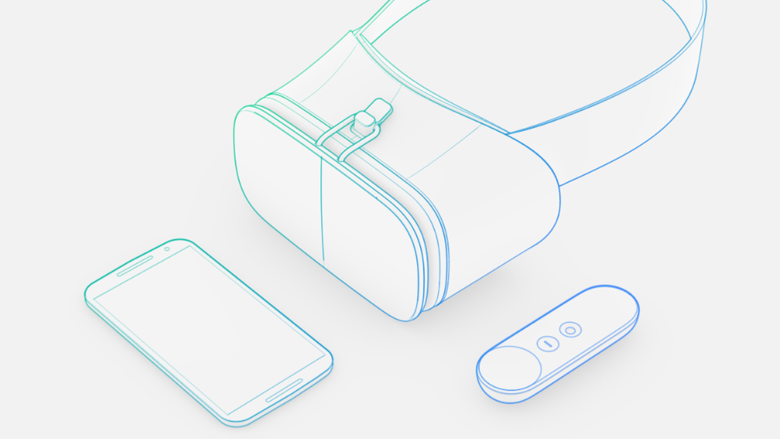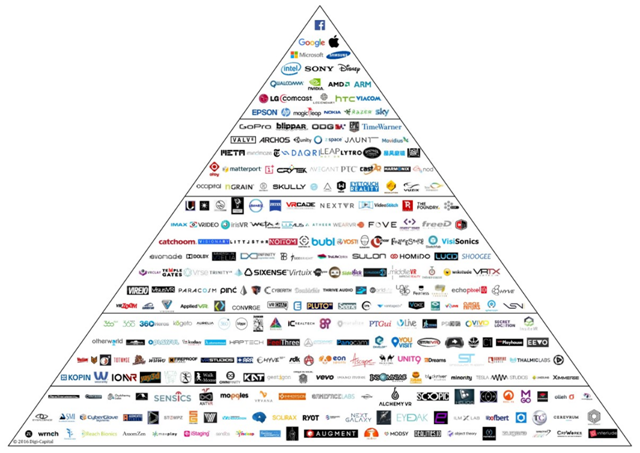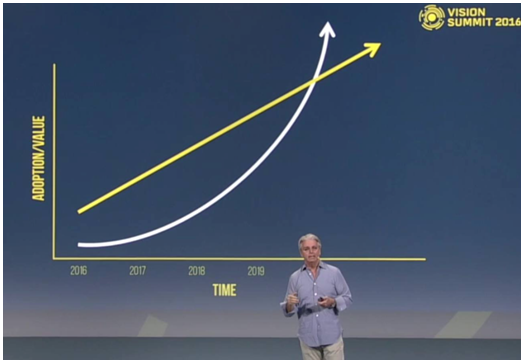How will the appearance of Daydream affect the VR market?
The other day Google announced a new VR platform for mobile devices – Daydream. We talked to Russian developers of VR projects and experts in this field about the platform.

Daydream is, according to Google, a platform that aims to improve the experience of interacting with virtual reality for mobile device users.
The platform means an entire ecosystem, including not only software solutions and a showcase, but also virtual reality glasses with a remote control, as well as a wide range of smartphones that will support the platform. Among the manufacturers of the latter there are such companies as Samsung, HTC, LG, Xiaomi, Huawei, ZTE, Asus and Alcatel. The first devices working with Daydream will appear this fall.
In connection with the announcement, we asked the market experts a few questions.
What, in your opinion, does the announcement of the Daydream platform mean for the VR market and its gaming segment?

Sergey Orlovsky, CEO of Nival
This is the new standard of mobile VR. Extremely useful for the market.

Konstantin Sakhnov, Director of Rocket Jump Game Design Department
It’s no secret that the VR market is developing very actively. The number of publications in gaming media is growing exponentially. VR content is finally appearing. However, do not build illusions. At the moment, there is no serious money in AR/VR. Companies that generate revenue from virtual reality content and equipment can be counted on the fingers.

Roman Povolotsky, Managing Partner of Other Kind Games
This means a big start for everyone. One of the key technology platforms has announced the emergence of a new market, which will cause rapid growth of the industry in the coming years.
In fact, Google has told all developers that it is ready to distribute content to users and, most importantly, existing phones will be the carrier, which greatly simplifies the user’s contact with VR content. The fact that you do not need to buy individual devices specifically for this will accelerate the expansion of the market.

Maria Suvorina, project owner at InfoShell
At the moment, opinions about the VR market itself, its right to exist and the right to be called a “market” are very different. Many do not believe in the near future of VR and attribute the date of the appearance of “real” virtual reality to the 20s. Adherents of the view of VR as an adult, dynamically developing direction find it difficult to argue their point of view, given what is happening. Some cardboard boxes for mobile devices, a crude prototype of the Oculus Rift, purchased for a crazy amount by Facebook (regarding the prospects of which there are also a lot of questions), and, finally, the inability to receive adequate feedback from users in view of the cost of advanced devices such as HTC Vive.
Developers also get it – many people want to try themselves in VR development, but it is not at all clear who will need it and what are the chances of somehow recouping the development. There are also acute issues of product development – how to make the user’s brain “believe” in another reality and at the same time not get negative consequences.
The announcement of Daydream may not seem like a direct impetus to the development of virtual reality technology – in fact, Google is not offering a new advanced device (it’s better than Cardboard, but not a new word in VR devices), but an ecosystem. It will allow developers to narrow down the search for solutions for optimization for mobile devices of different companies. Also, within the framework of Daydream, there is a solution for an add-on over the interface of the application itself in the form of a store. Yes, this is an existing solution on the market, but one way or another it solves the issues of allocating applications for VR into a full-fledged product category, as well as the possibility of making a purchase by the user without significant loss of immersion.
And, finally, the interest in this direction and the release of a new mass-market solution by a company like Google (let’s leave the moment with Google Glass), gives hope for this very “The future is now”. And this fuels the interest of investors (both large and private) in VR development, which gives a chance not only to giants of the EA order, but also to small teams. And as you know, it is in them that solutions and products are sometimes born that push the industry forward.

Vasily Filippov, CEO at MEL Science
This is a very serious claim by Google that the company wants to become a big player in this market. Google Cardboard was the most popular platform for virtual reality, but it was much inferior to all the others in quality. Daydream should combine mass character with the quality of the next generation.

Vyacheslav Utochkin, Director of educational programs in the gaming industry of the Higher School of Business Informatics
The announcement and further launch of the platform give the virtual reality market another technological push that will help bring VR out of the trend into the mainstream for both game developers and other segments in the next few years. Analysts predict an annual explosive growth of the market, including due to factors such as support from IT giants, an example of which we see now as part of the release of the Google Daydream platform.
In addition to Google, other major IT companies are now pouring billions of dollars into development, research and promotion of augmented and virtual reality technologies. Which companies, you can see on the convenient “pyramid of the market” for the first quarter of this year from Digi-Capital.

It seems to me that explosive growth in the market will occur closer to 2020, when such restraining factors as high prices for VR devices for the end user, the inconvenience of using them, psychological factors such as fear of a negative impact on health, imperfection of current technologies, etc. will be partially overcome. Unity CEO John Riccitello reflected market growth expectations very well. Yellow is forecasts, and white is how it will be in reality.

What features would you like to get implemented within the framework of the platform?

Sergey Orlovsky, CEO of Nival
We need the functionality of selecting and launching applications, as well as making purchases without removing the helmet.

Konstantin Sakhnov, Director of Rocket Jump Game Design Department
Reasoning from the position of game developers, we can only talk about new features approximately. Until monetizable genres interesting to a wide audience are established in VR, everything we do can only be called an experiment.

Roman Povolotsky, Managing Partner of Other Kind Games
Google is fine with product positioning. It has everything for development and earnings, because the “ball” has moved to the side of developers and manufacturers of smartphones and devices for VR. Here everything is just unambiguous and clear.
It is unclear which content will be in the greatest demand, but this is again in the hands of developers. A lot of people are now puzzling over what kind of content to release in order to get a new Angry Birds, because everyone wants to get organic growth along with the growth of the platform itself. Therefore, good luck to all of us!

Maria Suvorina, project owner at InfoShell
It’s hard to judge before the platform becomes more tangible. I would like to count on a simple integration of Google Play Game Services analogues adapted to the nuances of VR.
Also, in the course of working with the Cardboard SDK, there are many difficulties with the inter-focal distance (the same thing that makes the picture voluminous, among other things), I would like to solve these issues easier and better within the framework of the new platform.
Well, it would be interesting to see where the platform will (and will) develop in terms of integrating native advertising, which in fact is one of the main sources of income for Google Play applications.

Vasily Filippov, CEO of MEL Science
The most important thing is a significant reduction in delays and a convenient way to control through a separate controller. Just what we were shown. Most of the Google Cardboard problems were actually the result of large delays. For example, a small viewing angle was made intentionally to reduce the unpleasant impressions of delays. Now that the problem with delays is almost solved, nothing prevents us from making optics with good viewing angles, which we will most likely see.

Vyacheslav Utochkin, Director of educational programs in the gaming industry of the Higher School of Business Informatics
• Official SDKs of all key engines, including Unity and Unreal.
• iOS support
How much, from your point of view, is it more/less interesting/promising compared to the already released solutions from HTC, Samsung and Fibrum, why?

Sergey Orlovsky, CEO of Nival
Since this is a standard from the owner of the platform, it is obviously much more promising than any standards of device manufacturers who will be forced to switch to it.

Konstantin Sakhnov, Director of Rocket Jump Game Design Department
Fibrum has already established itself in the Russian market as the simplest device for testing applications for virtual reality. It is convenient because it can be used with most smartphones like Google Cardboard.
In contrast, Daydream, like Samsung Gear VR, requires quite specific smartphone models. The cost of the new device will also be important. I think it will not be more expensive than similar offers from Samsung and HTC.

Roman Povolotsky, Managing Partner of Other Kind Games
Users will go to where the greatest concentration of content is. As a platform, Google is in a position of strength, because their software is used on smartphones, and they will become the main VR devices. Why buy a helmet separately if you can use a smartphone for these purposes? Companies like Fibrum will probably have to concentrate on publishing content, since Google will provide its own service and technology in everything else, which will make it easier for everyone else, because a single standard will appear.

Maria Suvorina, project owner at InfoShell
The main issue today is the question of price and its adequacy to how much the player is immersed in virtual reality using the device and how comfortable he is there.
I wouldn’t compare Daydream with HTC when it comes to Vive. This is even in the perspective of a platform of a completely different level.
If we talk about existing solutions from Samsung or Fibrum, then the prototype of the Daydream device at least looks much cooler in terms of design and usability. With regard to Samsung, it can also be noted that Google and Daydream are trying to remove restrictions on manufacturers of devices for the platform, thereby expanding the audience. Samsung has taken the path of monopolization, which is likely to lead either to the completion of the Samsung Gear VR project, or to the need to switch to the Daydream development trajectory.

Vasily Filippov, CEO at MEL Science
I think it will be the most massive platform for virtual reality. The only competitor in terms of mass is Samsung’s Gear VR (Oculus software platform). There will be a great battle between these two players for the massive virtual reality segment in the near future.
Google has another trump card not played in its pocket – the Google Tango project. There is a lot of talk about it on Google I/O, but Daydream is not yet using all the features of this technology. Potentially, Tango will allow Google to get the same motion tracking capabilities that HTC Vive currently has, without installing external sensors in the room.

Vyacheslav Utochkin, Director of educational programs in the gaming industry of the Higher School of Business Informatics
The company has every chance to create unified technical standards for controls and controllers. It is clear that controllers for mobile VR have been around for a long time, both in the format of separately sold devices and bundled with some platform solutions. But Google will finally make it massive, which means profitable for developers. For such projects, which are already being filed using controllers for mobile VR, the Daydream output can become the best elevator to a bright future, a ticket for which Google is giving this year. Well, the payment for the benefit will be the work of developers to adapt existing applications to new controllers.